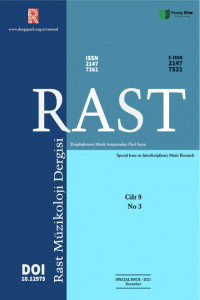A study on film score applying the Neo-Riemannian theory: focusing on Bernard Herrmann’s mysterious island
Abstract
This paper, takes three pieces of music in the film score work Mysterious Island by film music composer Bernard Herrmann (1911-1975) as the analysis object. Bernard Herrmann's composition techniques are very innovative, and even difficult to interpret harmonic design when analyzing his works with tonal music. The Neo-Riemannian theory formed in the 1980s is used to analyze the chord progression that cannot be accurately explained by tonal music analysis in Bernard Herrmann's film score, and to prove the Neo-Riemannian theory by marking the transformation methods used and deriving the evolution process of harmony Neo-Riemannian theory's rationality and superiority in analyzing film music. This study hopes to use the Neo-Riemannian theory to provide a new perspective for exploring the development of film musicology.
Keywords
Neo-Riemannian theory Transformational Theory Bernard Herrmann Film Score Mysterious Island
References
- Reference1 Cook, Nicholas. A Guide to Musical Analysis. W. W. Norton & Company, 1992.
- Reference2 Cohn, Richard. Audacious Euphony: Chromatic Harmony and the Triad's Second Nature. Oxford University Press, 2012.
- Reference3 Cohn, Richard. “Introduction to Neo-Riemannian Theory: A Survey and a Historical Perspective.” Journal of Music Theory 42, No. 2, (1998): 167-169.
- Reference4 Davis, Richard. Complete Guide to Film Scoring. Berklee Press; 2nd edition, 2010.
- Reference5 Douthett, Jack and Steinbach, Peter. “Parsimonious Graphs: A Study in Parsimony, Contextual Transformations, and Modes of Limited Transposition.” Journal of Music Theory 42, No. 2, (1998): 245-247.
- Reference6 Herrmann, Bernard. Mysterious Island. Directed by Cy Endfield. Los Angeles: Columbia, 1961.
- Reference7 Lewin, David. Generalized Musical Intervals and Transformations. Oxford University Press, 2007.
- Reference8 Lehman, Frank Martin. “Reading Tonality Through Film: Transformational Hermeneutics and the Music of Hollywood.” Ph.D. Diss., Harvard University, 2012 : 1.
- Reference9 Lehman, Frank. “Film Music and Neo-Riemannian Theory”. Oxford Handbooks Online: Aug 2014. https://www.oxfordhandbooks.com/view/10.1093/oxfordhb/9780199935321.001.0001/oxfordhb-9780199935321-e-002 (accessed Sep 15, 2021).
- Reference10 Murphy, Scott. “Transformational Theory and the Analysis of Film Music,” in The Oxford Handbook of Film Music Studies, ed. David Neumeyer. Oxford University Press, 2013.
A study on film score applying the Neo-Riemannian theory: focusing on Bernard Herrmann’s mysterious island
Abstract
This paper, takes three pieces of music in the film score work Mysterious Island by film music composer Bernard Herrmann (1911-1975) as the analysis object. Bernard Herrmann's composition techniques are very innovative, and even difficult to interpret harmonic design when analyzing his works with tonal music. The Neo-Riemannian theory formed in the 1980s is used to analyze the chord progression that cannot be accurately explained by tonal music analysis in Bernard Herrmann's film score, and to prove the Neo-Riemannian theory by marking the transformation methods used and deriving the evolution process of harmony Neo-Riemannian theory's rationality and superiority in analyzing film music. This study hopes to use the Neo-Riemannian theory to provide a new perspective for exploring the development of film musicology.
Keywords
Neo-Riemannian theory Transformational Theory Bernard Herrmann Film Score Mysterious Island
References
- Reference1 Cook, Nicholas. A Guide to Musical Analysis. W. W. Norton & Company, 1992.
- Reference2 Cohn, Richard. Audacious Euphony: Chromatic Harmony and the Triad's Second Nature. Oxford University Press, 2012.
- Reference3 Cohn, Richard. “Introduction to Neo-Riemannian Theory: A Survey and a Historical Perspective.” Journal of Music Theory 42, No. 2, (1998): 167-169.
- Reference4 Davis, Richard. Complete Guide to Film Scoring. Berklee Press; 2nd edition, 2010.
- Reference5 Douthett, Jack and Steinbach, Peter. “Parsimonious Graphs: A Study in Parsimony, Contextual Transformations, and Modes of Limited Transposition.” Journal of Music Theory 42, No. 2, (1998): 245-247.
- Reference6 Herrmann, Bernard. Mysterious Island. Directed by Cy Endfield. Los Angeles: Columbia, 1961.
- Reference7 Lewin, David. Generalized Musical Intervals and Transformations. Oxford University Press, 2007.
- Reference8 Lehman, Frank Martin. “Reading Tonality Through Film: Transformational Hermeneutics and the Music of Hollywood.” Ph.D. Diss., Harvard University, 2012 : 1.
- Reference9 Lehman, Frank. “Film Music and Neo-Riemannian Theory”. Oxford Handbooks Online: Aug 2014. https://www.oxfordhandbooks.com/view/10.1093/oxfordhb/9780199935321.001.0001/oxfordhb-9780199935321-e-002 (accessed Sep 15, 2021).
- Reference10 Murphy, Scott. “Transformational Theory and the Analysis of Film Music,” in The Oxford Handbook of Film Music Studies, ed. David Neumeyer. Oxford University Press, 2013.
Details
| Primary Language | English |
|---|---|
| Subjects | Music |
| Journal Section | Interdisciplinary Music Research |
| Authors | |
| Early Pub Date | December 31, 2021 |
| Publication Date | December 31, 2021 |
| Published in Issue | Year 2021 Volume: 9 Issue: 3 |
Yazarlarımızın editöryal süreçlerin aksamaması için editöryal emaillere 3 gün içinde yanıt vermeleri gerekmektedir.


